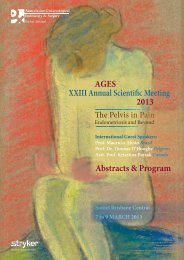You also want an ePaper? Increase the reach of your titles
YUMPU automatically turns print PDFs into web optimized ePapers that Google loves.
<strong>AGES</strong> Focus Meeting Sheraton ENDOSCOPY Perth Hotel, FOR West Australia FERTILITY 20 & 21 November 200817CIN TREATMENT AND FERTILITYFriday 21 November / Session 9 / 1410-1430McElhinney BDetection and treatment of CIN greatly decreases the riskof cervical cancer. The peak incidence of severedysplasia occurs in women aged 25-29, a time when manywomen are considering pregnancy. Therefore the impactof CIN treatment on fertility is of great importance.Historically, hysterectomy or cold knife conisation wasthe standard of care. Since the 1980’s, more conservativeout-patient excisional treatments of the transformationzone have become popular.Currently LLETZ is the treatment of choice worldwide.The procedure is easy, inexpensive, effective asearlier/alternative methods and provides a surgicalspecimen. However, excisional treatment of any kind mayaffect the mechanical support of the cervix withimplications for future pregnancies.Absolute indications for cold knife conisation includesuspicion of an early invasive cancer, significantglandular abnormality and incompletely seen lesions inthe presence of a high grade squamous abnormality.Early case series and retrospective cohort studiesdescribe the impact of cold knife conisation on pretermbirth. However, the studies were small & inadequatelypowered with variable composition of comparativegroups; few undertook multivariate analyses to adjust forpotential confounders. Total number of cases was 558and the relative risk of preterm births was 2.9.There are ten cohort studies published in the EnglishLanguage peer reviewed literature on the effect of LLETZon preterm birth. The largest and most recent studiesboth show a significant association between LLETZ andspontaneous preterm birth and with pPROM.In summary it is probable that excisional therapiesincrease the risk of spontaneous preterm birth. However,the data regarding the amount of tissue removed areimprecise. Further research is needed to confirm thelikely effect of excisional treatments on the subsequentrisk of spontaneous preterm birth.Author Affiliation: Dr Bernadette McElhinney. KingEdward Memorial Hospital for Women, Subiaco, WA,Australia.UTERINE PRESERVATION. VAGINAL APPROACHFriday 21 November / Session 10 / 1430-1450Maher CUterine preservation at prolapse surgery is increasinglybeing considered by women due to a delay inchildbearing to a later age, a belief that the uterus plays arole in sexual satisfaction and successful conservativetreatments for the control of menorrhagia. In womenwishing uterine preservation a variety of surgical optionsare available including the Manchester repair andsacrospinous hysteropexy vaginally, and uterosacralhysteropexy and sacral hysteropexy abdominally.The Manchester repair has largely been abandoned dueto recurrence of prolapse in excess of 20% in the first fewmonths, decrease in fertility, pregnancy wastage as highas 50% and future sampling of the cervix and theendometrium can be difficult due to vaginal reepithelializationor cervical stenosis.The sacrospinous hysteropexy is a safe and effectiveprocedure as compared to vaginal hysterectomy andsacrospinous colpopexy for uterine prolapse. Twocomparative studies involving 165 women with at least amean 2-year review are available and demonstrate theoperating time, blood loss and complications are reducedin the hysteropexy group with success rates of 90%being reported in both groups1,2. Only limited data isavailable on pregnancy outcome following sacrospinoushysteropexy as Hefni et al who contributed 109 women tothe literature only reported in women over 60 years.Seven pregnancies have been reported with 2 (29%)undergoing further prolapse surgery, one each followingvaginal and caesarian delivery1,3.Anterior compartment prolapse has been problematicfollowing sacrospinous hysteropexy. Also recent RCTShave demonstrated at 1 year that the use ofpolypropelene mesh significantly reduces the rate ofrecurrent prolapse at 1 year as compared to anteriorcolpoharraphy4-6 . Finally vaginal hysterectomy has beenassociated with 5x higher rate of mesh erosions ascompared to mesh repairs with no hysterectomy7. Thesethree factors have encouraged us to perform vaginaluterine preservation and anterior mesh for themanagement of uterovaginal prolapse. Information on ouroutcomes for sacrospinous hysteropexy, anterior meshand posterior repair will be reported.Several authors have reported objective success rates ofover 90% with sacral hysteropexy8,9 where meshsecures the cervix to the sacrum. Roover’s et al in a
















